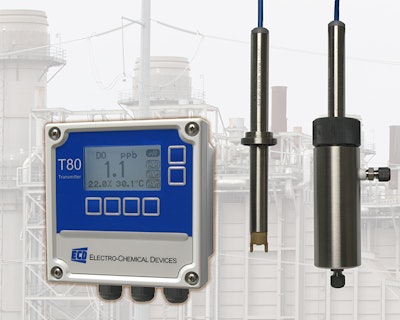

Process and plant engineers who need to improve boiler efficiency, reduce maintenance and lower costs will find the new plug-n-play rack mount DO90 Trace DO2 Analyzer from Electro Chemical Devices (ECD) provides continuous precision measurement and alarming of trace dissolved oxygen (DO2) levels in boiler feed water supporting electric power generation steam turbine systems.
Oxygen should only be present in trace quantities in boiler feed water for steam turbine systems because excessive concentrations of oxygen can result in corrosion damage to the components of the boiler's steam cycle. Oxygen in the feed water of high-pressure boilers attacks the boiler’s metal construction, leading to severe pitting. In addition, the iron oxide produced by the corrosion leaves iron deposits requiring additional system maintenance.
To remove the oxygen, the boiler feed water is pretreated by thermally or chemically degassing it to achieve oxygen-free water. This state must be maintained throughout the steam cycle. De-aeration is accomplished through the use of physical mediums, including de-aerating heaters or chemical mediums like oxygen scavengers.
Processes that rely only on periodic grab samples to monitor the ppb oxygen concentration in boiler feed water introduce the risk of significant sampling errors. Such sampling errors can eventually lead to the use of additional costly water treatment consumables and more frequent boiler maintenance cycles that can shorten boiler life.
To prevent these problems, the ECD Model DO90 Trace DO2 Analyzer features a lead silver, galvanic, dissolved oxygen sensor with a durable PFA Teflon® membrane. The sensor is combined with an intelligent universal transmitter designed for continuous service. The sensor is housed in a rugged, 316L flanged stainless steel body for use in rugged industrial process environments.
Oxygen diffusing through the DO90 sensor’s membrane is reduced at the cathode, producing hydroxide ions that react with the lead ions in the electrolyte to form lead hydroxide. The anode dissolves more lead ions into the electrolyte, sending electrons to the cathode to reduce any oxygen present. The current flows from the lead anode to the cathode. Under constant conditions, the current is proportional to the oxygen concentration of the medium.





















